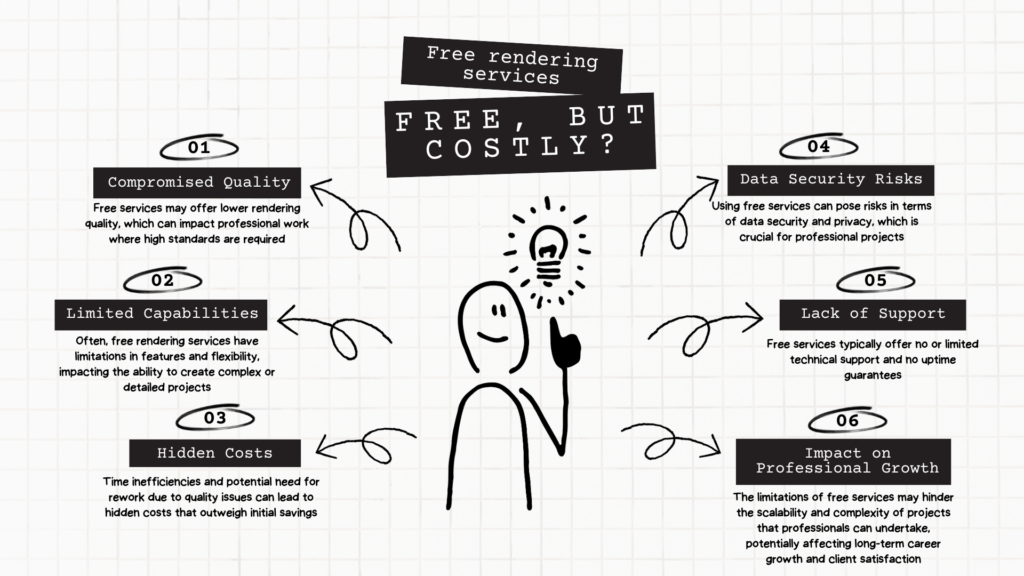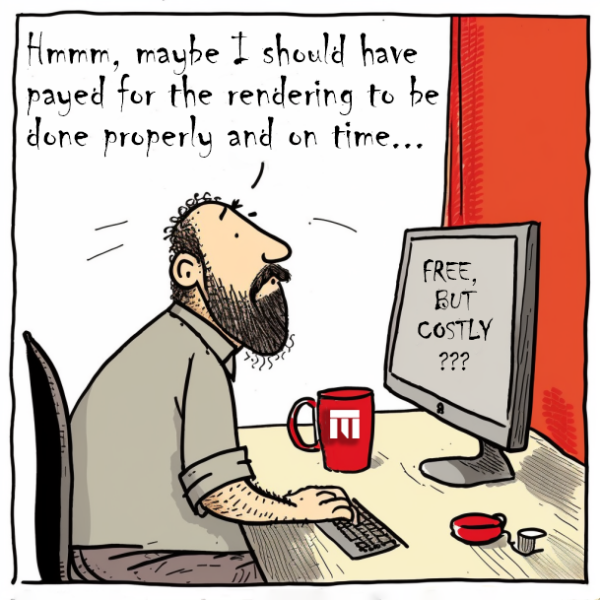
The idea of getting something for free is very irresistible, especially in 3D rendering, where costs can add up quickly. Free rendering services provide a cost-effective solution for 3D artists and small studios that want to visualize their work but cannot afford to invest in their own hardware or pay for rendering services.
People who are just starting or have a limited budget find free rendering great. The initial cost savings are a significant draw that allows them to use funds for other essential aspects of their projects or business operations.
In the next lines, we will see if the free rendering services are worth it and if they are the solution for your rendering needs.
The Attraction of ‘Free’: What Draws Users In
The word free attracts many people from various fields who are looking to cut costs. In the competitive world of 3D design and rendering, where the pressure of quickly delivering high-quality visuals is ever-present
The idea of a free rendering service seems like a dream come true. However, the allure of cost savings comes with potential compromises in rendering speed, quality, and capabilities.
Evaluating No-Cost Solutions
While the idea of not spending upfront is tempting, free rendering services might not deliver the desired professional quality. Challenges such as reduced rendering speed and limited rendering capabilities can impact project outcomes. Moreover, these services might not offer the advanced rendering software features necessary for creating detailed visual effects or handling complex project files efficiently.
Immediate Benefits: No Initial Investment
While not spending upfront is tempting, free rendering services might not deliver the desired professional quality. Challenges like reduced rendering speed and limited rendering capabilities can impact project outcomes.
Moreover, these services might not offer the advanced software features necessary for creating detailed visual effects or handling complex project files efficiently.
Quality Concerns: When Free Means Lower Standards
While the cost-saving aspect of free rendering services is undoubtedly appealing, it’s essential to consider the potential trade-offs in quality. The rendering speed, a critical factor in meeting project deadlines, may be compromised in free services.
Additionally, the final output may not meet the high standards required for professional work. These services often operate on a good enough principle, which can be problematic for professionals whose reputations hinge on the quality of their work.
Compromised Rendering Capabilities
Free rendering services could not offer the same rendering capabilities as the paid ones. Compromising can be revealed in several ways, such as longer render times due to limited processing power or a lack of advanced features essential for achieving visual effects.
For instance, the rendering capabilities required to produce complex lighting and textures might be beyond the scope of a free service. Professionals can leave with a final product that exceeds their vision and client’s expectations.
Impact on Visual Effects and Detailing
The limitations of free rendering services can be particularly evident in the VFX rendering and detailing. High-quality rendering is essential for bringing 3D models to life, and any shortcomings in this area can significantly detract from the realism and impact of the final product.
Professionals working on projects that require many details and visual effects may find that free services need more tools and features to achieve the desired outcome, potentially leading to a less competitive end product.
Hidden Costs: What are the Unseen Expenses
While the absence of upfront costs is a core selling point for free rendering services, often many hidden expenses emerge over time. These can take various forms, from the time spent waiting for slow renderings to process to the potential need for rework due to quality issues.
The time inefficiencies associated with free services can be particularly costly, as time is valuable in 3D rendering.
Time-Consuming Workarounds
Professionals using such services may end up using time-consuming workarounds to compensate for these platforms’ limitations. Whether you are tweaking render settings repeatedly or breaking down scenes into smaller chunks, these workarounds can add significant time to a project.
The additional hours spent managing these inefficiencies can quickly negate any initial cost savings, making the free service far less attractive in the long run.
Additional Expenses in the Long Run
Over time, free rendering services can lead to additional expenses that were not initially apparent. For example, professionals may need to invest in more powerful local hardware to handle pre-rendering tasks or post-rendering edits, as the free service may not provide the necessary capabilities.
On top of that, the need to redo work due to quality issues can result in missed deadlines and dissatisfied clients. These long-term costs can far exceed the price of investing in a reliable, paid rendering service from the outset.

Limitations in Features and Flexibility
Free rendering services often come with limitations that can significantly impact the workflow and final rendering output of 3D professionals. These limitations could range from restricted render settings to a lack of support for advanced software features. The constraints imposed by these services can stifle creativity and limit the ability to realize projects to their fullest potential.
Let’s see more below:
- Lack of advanced features and customization: Many free alternatives of paid 3D rendering services offer only a basic set of features, which can be insufficient for complex or highly detailed projects. Advanced software features, such as custom shaders, high-resolution textures, and sophisticated lighting options, are typically reserved for paid plans.
- Constraints on project scalability: Scalability is critical for 3D professionals, especially when working on large-scale projects or building 3D models that require significant resources. Free rendering services often have limitations on the size and complexity of projects they can handle, which can be a considerable obstacle for professionals looking to expand their work or take on more ambitious projects.
The inability to scale up can force professionals to compromise on the scope of their projects or seek out more capable and often more costly rendering solutions.
Data Security Risks in Free Rendering Services
Professionals should stay alert to the potential data security risks when using free rendering services. Rendering sensitive project files on remote servers, especially those provided by free services, can expose users to the risk of unauthorized access and data breaches.
These risks can have significant consequences, not only for the security of intellectual property but also for client confidentiality and trust.
Risks of Data Breaches and Loss
Free rendering services might not always follow the strict security rules of paid services. Lack of security measures can leave project files vulnerable to data breaches, potentially leading to the loss of proprietary designs or confidential information.
For professionals working with sensitive data, the risks associated with free services can outweigh the benefits, as the repercussions of a data breach can be far-reaching and damaging to one’s career and business.
Compliance and Privacy Concerns
Compliance with industry standards and privacy regulations is another area where free rendering services may fall short. Professionals are responsible for ensuring that their work adheres to relevant laws and standards, and free rendering services may not provide the necessary assurances or certifications.
This lack can be particularly problematic for projects that require compliance with specific regulations, such as those in the medical field, where data is subject to strict legal requirements.
Support and Reliability: Often Overlooked Aspects
Technical support and reliability are critical components of any rendering service, yet often overlooked when considering free options. The level of support provided by free services is typically minimal, which can be a significant disadvantage when technical issues arise.
The reliability of these services can be questionable, with no guarantees of uptime or performance, which can be detrimental to project timelines and overall workflow.
When considering using such service, pay attention to the following:
- Availability of technical support: Access to prompt and knowledgeable technical support is essential for resolving issues that may arise during the rendering process. Free services often offer limited or no technical support, leaving users to handle problems alone.
- Uptime and reliability guarantees: For professionals who rely on rendering services to meet tight deadlines, the reliability of these services is of utmost importance. Free rendering services typically do not offer uptime guarantees, which can lead to unexpected outages and delays.
Paid cloud rendering services often provide service level agreements (SLAs) that guarantee a certain level of performance and reliability, giving professionals peace of mind and a more stable working environment.
Long-Term Implications for Professional Projects
Free rendering services might look like a good deal now, but they can cause problems for professional work later. They may worsen the quality and timing of projects and damage your career and reputation if using such services.
Other concerns are the following ones:
- Professional reputation and client trust: For 3D professionals, maintaining a good reputation is crucial for attracting and retaining clients. The use of free rendering services can risk this reputation if the quality of the work is compromised. Clients expect high-quality, detailed renderings, and the inability to consistently deliver this standard can lead to a loss of trust and potentially harm future business opportunities.
- Future growth and scaling potential: As professionals and studios grow, their projects become more complex and demanding. Free rendering services are limited, don’t grow with your needs, and can slow your progress.
The inability to scale or process complex projects or to provide real-time rendering can force professionals to seek alternative solutions, potentially disrupting established workflows and client relationships.
Alternatives to Free Services: Weighing the Options
Considering the limitations and risks of free rendering services, we recommend you explore alternatives that can provide better rendering outcomes, enhanced features, and reliability. A paid cloud rendering service or dedicated GPU servers are viable options that can offer the necessary capabilities for professional-grade work.
Benefits of Cloud Rendering Services
Cloud rendering services offer many benefits, including access to powerful remote servers that can dramatically increase rendering speed and efficiency. These services allow professionals to leverage advanced rendering programs and GPU rendering capabilities without investing in expensive hardware.
Cloud rendering also offers the flexibility to scale resources up or down based on project requirements, ensuring you only pay for what you need.
Investing in Dedicated GPU Server Rentals
Dedicated GPU servers provide access to high-end unshared CPU and GPU resources that can significantly enhance rendering capabilities. This option eliminates compatibility issues and enables complete customization of the rendering environment, including your preferred 3D rendering software and render settings setup.
Although dedicated servers come with a price, the long-term benefits, including better rendering outcomes and the ability to handle time-consuming, complex projects, can outweigh the initial investment.
Comparing Costs and Benefits: Free vs Paid Solutions
When comparing free rendering services with paid alternatives, it is essential to consider the immediate costs but also the long-term value. Paid solutions may require an upfront investment, but they often provide reliability, support, and security, which are critical for professional work.
Additionally, the ability to deliver high-quality, detailed renderings can lead to increased client satisfaction and more business opportunities, ultimately justifying the investment in paid rendering solutions.

Conclusion
Even though free rendering services seem like a solution for some 3D professionals to save money, it’s better to think about possible problems with quality, unexpected costs, and future effects.
Alternatives such as cloud rendering services and dedicated GPU server rentals can provide the necessary features, flexibility, and reliability required for professional-grade projects, making them a worthwhile investment for those looking to produce high-quality work and grow their business.
Frequently Asked Questions
-
What are some hidden costs associated with using free rendering services?
While the upfront cost is minimal, these services may have limitations on features, rendering quality, and processing speed, leading to inefficiencies. Users might invest in additional software or hardware to compensate for these limitations.
-
How do the quality and flexibility of free rendering services compare to paid services?
Free rendering services typically offer lower quality and flexibility than paid alternatives. They often have limited rendering capabilities, supported file formats, and the range of features available. This lack can result in lower resolution outputs, limited control over rendering settings, and a lack of advanced features like batch rendering or detailed texture handling.
Some extra read on the matter: 4 Limitations of Current Rendering Software and What We Can Expect in the Future
